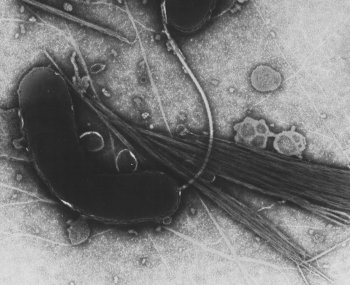Vibrio cholerae: Difference between revisions
Shanshan Cen (talk | contribs) No edit summary |
Shanshan Cen (talk | contribs) No edit summary |
||
| Line 40: | Line 40: | ||
==References== | ==References== | ||
{{reflist|2}} | |||
== External links == | == External links == | ||
Revision as of 12:53, 8 July 2015
| Vibrio cholerae | ||||||||||||||
|---|---|---|---|---|---|---|---|---|---|---|---|---|---|---|
 TEM image
| ||||||||||||||
| Scientific classification | ||||||||||||||
| ||||||||||||||
| Binomial name | ||||||||||||||
| Vibrio cholerae Pacini 1854 |
Vibrio cholerae is a gram negative bacterium with a curved-rod shape that causes cholera in humans.[1] V. cholerae and other species of the genus Vibrio belong to the gamma subdivision of the Proteobacteria. There are two major strains of V. cholerae, classic and El Tor, and numerous other serogroups.
V. cholerae was first isolated as the cause of cholera by Italian anatomist Filippo Pacini in 1854, but his discovery was not widely known until Robert Koch, working independently thirty years later, publicized the knowledge and the means of fighting the disease.
Habitat
V. cholerae occurs naturally in the plankton of fresh, brackish, and salt water, attached primarily to copepods in the zooplankton. Coastal cholera outbreaks typically follow zooplankton blooms. This makes cholera a typical zoonosis.
Pathogenesis
V. cholerae colonizes the gastrointestinal tract, where it adheres to villous absorptive cells via pili, and secretes a binary toxin, called cholera toxin (CT). The two CT subunits are named A and B, and are synthesised in a 1:5 ratio. B subunits bind and internalize A subunits, which are processed to A1. The A1 form catalyses ADP ribosylation from NAD to the regulatory component of adenylate cyclase, thereby activating it. Increased adenylate cyclase activity increases cyclic AMP (cAMP) synthesis causing massive fluid and electrolyte efflux, resulting in diarrhea.
CT is encoded by the ctxAB genes on a specific filamentous bacteriophage. Transduction of this phage is dependent upon bacterial expression of the Toxin Coregulated Pilus (TCP), which is encoded by the V. cholerae pathogenicity island (VPI). VPI is generally only present in virulent strains and is laterally transferred. VPI was originally thought to encode a filamentous phage responsible for transfer. This theory was discredited by a study of 46 diverse V. cholerae isolates which found no evidence of VPI phage production. The generalized transduction phage CP-T1 has been shown to transduce the entire VPI which is then integrated at the same chromosomal location. Also, VPI has been shown to excise and circularize to produce pVPI via a specialised mechanism involving VPI-encoded recombinases. It is not known whether pVPI is involved in CP-T1 transduction or if it is perhaps a component of an alternative VPI mobilization mechanism.
Additionally, it produces two different proteases called chitinase and mucinase. Chitinase is responsible for the ability of Vibrio cholerae to enter copapods. Mucinase is a non-specific protease that assists entry into the human gastro-intestinal tract.
Finally, Vibrio cholerae produces what is called a ZOT toxin, termed as "Zona Occludans Toxin". This toxin specifically attacks the zona occludans or "tight" junctions joining epithelial cells.
Treatment
Water and electrolyte replacement are necessary in treating cholera. In some cases, tetracycline may be used. A vaccine is available outside the US, but it is short-lived and not currently recommended by the CDC.[2] Fluoroquinolones such as norfloxacin are used, but resistance has been reported.[3].
Treatment
Antimicrobial regimen
References
- ↑ Ryan KJ; Ray CG (editors) (2004). Sherris Medical Microbiology (4th ed. ed.). McGraw Hill. ISBN 0838585299.
- ↑ "Is a vaccine available to prevent cholera?". CDC Disease Info: Cholera. Retrieved 2007-01-21.
- ↑ .Recently Hemendra Yadav reported his findings at A.I.I.M.S.,New Delhi that Ampicillin resistance has again decreased in V.cholerae strains of DelhiKrishna BVS, Patil AB, Chandrasekhar MR (2006). "Fluoroquinolone-resistant Vibrio cholerae isolated during a cholera outbreak in India". 100 (3): 224&ndash, 26. doi:10.1016/j.rstmh.2005.07.007. Unknown parameter
|jounal=ignored (help)
External links
bn:ভিব্রিও কলেরী
de:Vibrio cholerae
it:Vibrio cholerae
he:Vibrio cholerae
nl:Vibrio cholerae
sk:Vibrio cholerae